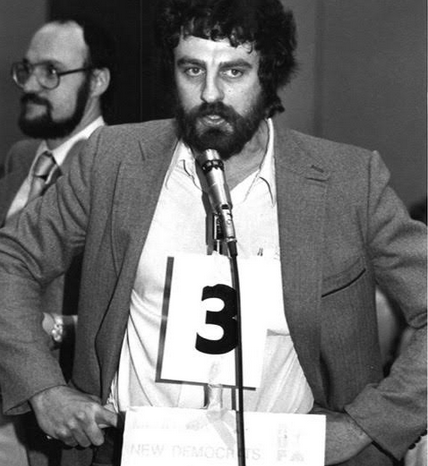
by Doug Smith
In the late 1970s, it was almost impossible to open a newspaper or listen to a local news broadcast and not run up against Jay Cowan’s name. In the morning one could hear the shaggy New Democratic Party MLA from Churchill tying the Conservative government’s labour minister up in knots over lead poisoning in Winnipeg’s antiquated smelting plants, at noon he would be eviscerating the environment minister for the misuse of pesticides along northern Manitoba roadways, while at sign-off time, Cowan could be heard giving the minister responsible for Emergency Measures a Dutch rub for bungling the response to a train derailment that had leaked vinyl chloride into the environment. To the Conservative government of Sterling Lyon, Cowan must have seemed like the damned elusive Scarlet Pimpernel: Here, there, and everywhere. I remember the newly arrived Winnipeg correspondent for the CBC’s Sunday Morning radio current affairs show, asking me, only slightly in jest, “Is there anyone else in the NDP caucus besides Jay Cowan?”
Jay died last month. He had been out of the public eye since his resignation from the legislature in 1990. His career after leaving political office was eclectic and impactful: restaurateur, consultant, and then, for many years, running, with his wife Elaine Cowan, an adult education centre that focused on meeting the needs of Indigenous people. Anyone who reads the tributes former students have posted on his obituary page will learn of what an inspirational figure he was in that role.
There are, in other words, many reasons to remember and honour Jay Cowan. Perhaps the most significant is the role he played in making workplace health a political issue in Manitoba. He did not do this alone. In 1978, the provincial director of workplace health and safety Victor Rabinovitch resigned to protest a Conservative government cut in his branch’s staffing, members of his staff who stayed behind were appalled by the government’s hands-off attitude towards enforcement, Luis Rufo, a young tool-and-die maker who had been recently hired by the Moulders’ Union, was fired by a blazing passion to protect his members, Larry Marshall, the Winnipeg Tribune’s labour reporter was an instinctive champion of the underdog—combining compassion and investigative diligence. And there were dozens of workplace activists: workers at risk and workers who dared to come forward and speak of their stories.
The initial battlefield in this war for cleaner workplaces were the smelters of the city’s Weston district. Reports were leaked to Cowan that workers were regularly being tested with dangerous lead in blood levels. They were treated with chemicals that flushed the lead out of their bodies and told to stay off work until their lead levels had fallen. Then they would be recalled, and once more, filled up with lead. Cowan made sure that this scandalous treatment made the news: he and Rufo said the problem was not sick workers, but a sick workplace.
Company doctors were also not sharing test results with workers. Cowan and Rufo realized that they needed their doctors: Winnipeg doctor Percy Decter began to see the workers from the smelting plants. For many of them, it was the first time a doctor had spoken to them about what was going on in their workplace or given them the results of lead-in-blood tests. From these experiences came a recognition of the need for a workers’ health clinic. Cowan, who had worked as a miner in northern Manitoba before being elected to the legislature in 1977, collaborated with Rufo and Dick Martin, the president of the Manitoba Federation of Labour, and the Manitoba School of Social Work, on a proposal for an occupational health centre. While they sought government funding, they were determined to set up a centre with or without government support. Armed with a slide-tape show Cowan, who was simultaneously a member of the legislature and the chair of the MFL Workplace Health and Safety Committee, hit the union local meeting circuit. By the time he was done, he had raised over a quarter of a million dollars. The MFL Occupational Health Centre opened its doors in 1983, the only second such worker centre in Canada.
Jay dreamed big, but he never sought personal aggrandizement. On more than one occasion he dropped an expose in a reporter’s lap. Here were the leaked reports, here were the numbers of the workers who were willing to talk about the issue, where were the experts who could set the story in context. No, he did not think you needed to interview him for the story: the story was about the workers.
As one who was lucky enough to be a spear carrier in the rag-tag army that Jay summoned into action, I am also staggered and humbled by all the things that he did in a few years that the limitations of space require that I leave out. There is much, much more that could be told. He was brilliant in his eloquence, generous in his humour, and he worked like a son-of-a-gun. He not only believed, to use the motto of the Knights of Labour, that “An injury to one was an injury to all,” he did something about it.
Doug Smith is a Winnipeg researcher, writer and author of numerous books on political and social issues.


